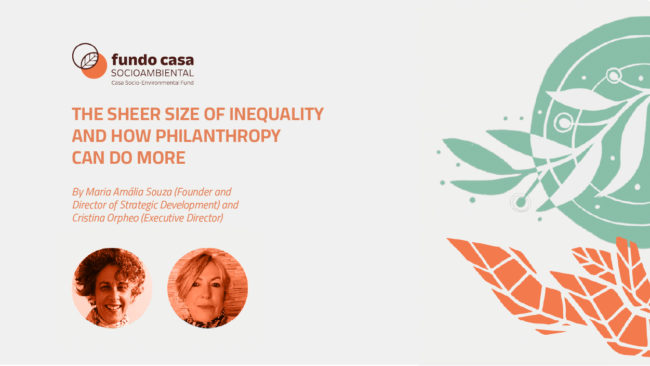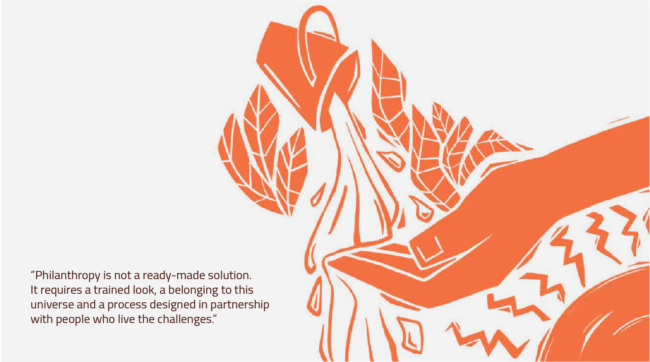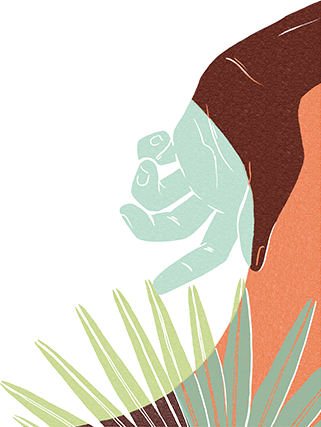 10.08.2022
10.08.2022
The sheer size of inequality and how philanthropy can do more
By Maria Amália Souza (Founder and Director of Strategic Development) and Cristina Orpheo (Executive Director)
The much talked about social inequality in Brazil has never been so wide open as in the period of the covid-19 pandemic. While a segment of the population continued working from home, saw profits increase through e-commerce and witnessed their children studying through virtual platforms and with online monitoring, another part saw the already scarce sources of income all but disappear. For many people unable to pay rent, the street was all that was left. For hundreds of children, school has become something distant. For a good part of Brazilians, hunger has begun to haunt once again.
And, to our sadness, the abyss of social inequality is many meters wider.
The pandemic seems to start to gain some semblance of control. On the other hand, the damage and pain it caused could take years to repair and heal, respectively. It would have been different if we lived in a more egalitarian society, where everyone had the same access and the same opportunities to have faced the crisis generated by Covid-19.
In the face of all this, we ask ourselves daily: what do we need to do so that this transformation takes place and the specter of inequality does not continue to increase every day? What, in fact, is needed to turn this game around? Is philanthropy a solution or is it part of the problem?
A path – Philanthropy for social justice can help build this path, based on the recognition of who are the real protagonists in the transformation processes, recognizing that the decision-making power must belong to the communities themselves, those that, in fact, are on the front lines of racial, gender, health, environmental, climate, housing and other forms of violation of their rights and territories.

A challenge – Philanthropy is not a ready-made solution. It requires a trained look, a belonging to this universe and a process designed in partnership with people who live the challenges. It is an art to ensure that resources arrive carefully, without stressing local relations, in order to elevate and consolidate the actions, and not belittle them even more.
However, this way of doing things does not even seem to be on the list of options for most high-level philanthropy, even coming from further afield, from the entire field of international cooperation. Within this vision, the private sources, as well as business and government sources, have always treated the most vulnerable groups as “clients” of their actions. The distance between these two realities is so immense that this conventional, structured, and, why not say, antiquated view has always treated the most excluded and vulnerable communities in our society as if they had no ability to solve their own problems. The solutions, in this distant vision, must come, necessarily, from the books of some experts. People without formal education or who come from original cultural traditions are not seen as protagonists of their own lives by this distant universe. In general, they are perceived only as the beneficiaries of some kind of charity that may come their way; as passive recipients, not actors. Therefore, in this view, solutions always need to come from outside – an institution that plays the role of executor on behalf of these populations, to receive, generally, generous amounts of resources, and to implement solutions designed “for” and not “by” this population considered “incapable”.
Of course, this universe is not binary. There are many attempts within this spectrum of players, who come from this level of financial possibilities, to do things differently, to get closer to the groups with whom they intend to work, listen and understand. But even so, there is unintended, unexpected, and most often unnoticed distortions that occur, until it is too late to correct—it is very difficult for incumbent individuals, with all the best intentions, to obtain the clearest and most objective information of the groups with whom they intend to ally and support – especially when these groups have a history of decades or centuries of exclusion. Expectations on both sides are very high and, shall we say, uneven. They are very distant universes, where objectivity has almost no space to exist. Sometimes the best of intentions are not enough for the best results to be possible. Therefore, the fault does not always come from those positioned at the top of the pyramid, but from the very incompatibility of worldviews.
This is exactly where we need to look more closely at some blocks of this structure, of which we have become so used to and which have become apparently an unquestionable status quo. We will start from a few points.
Power – We need to remove the filters that mask the structures of power from where we are (our organizations) to break all the paradigms that reproduce this system that causes the same inequality that we reject, but that ends up penetrating all the levels of our organizations. The antidote will always be to identify forms of “power over” and dismantle them block by block, to recreate horizontal relationships in their place. This ranges from decision-making processes, hierarchies, to care and exercise focused on respect for those whom we collaborate. Each dimension of power must be analyzed and dismantled, so that “power with” can be created, which is different from disfunctionality. There are relationships that can be the recognition of individual values, while still allowing a distribution of specific and assignable tasks and responsibilities.
The time – Philanthropy also needs to deal with the time required for transformation and invest in the medium and long term. Realities where there have been and are constantly still, violated rights, pain and blood for decades, cannot be changed in 12/24 month timelines. When one starts from the premise that whoever has the money dictates the rules, and if rules are borrowed from corporate practice to act in the social, the universe of action is very limited – and, with that, the real social impact that a financial investment could produce in the world. This is when this impact does not become negative and makes the circumstances even worse. The key to making good investments in this great objective is knowing that, to change the world, we must have persistence, dedication and a lot of patience.
Outscaling – This term, mentioned by Ashish Kothari of Global Tapestry of Alternatives, makes perfect sense to us in the field of philanthropy for social justice. We know that vulnerable populations within territories of great biodiversity are fundamental for the protection of the biome itself and that enabling a sustainable economy in these regions is one of the great answers to stimulate local conservation and regeneration. However, we have been concerned about the approaches generically called Social Impact Investments. And that when they use the same model of stimulating the consumption of some specific products in production chains, they encourage communities to increase this production – as it is the one with the most demand in the market – to the detriment of the wide variety of species that they traditionally cultivate and with which count on, in the right measure, to produce a decent income. This action, added to the concept of “upscaling” production, which fluctuates with the demand (or not) of the market, instead of producing solutions, may increase, even more, the abyss of inequality and be overwhelming for a community. Therefore, we work with the idea of “outscaling”, which stimulates the possible production of each product by an infinity of communities, ensuring that each species is cultivated and managed according to the conditions of each territory, and that, at the same time, the combination of collectively combined yields makes a real difference to the local economy, all the while demonstrating the economic viability of the standing forest.
Where to stimulate the economy and where to protect rights – Following this logic, the market is selective in its logic. It is looking for products that have a market and focuses on how to stimulate production. This is fine in places where conditions are already in place, where territories are guaranteed and the community is well organized, preferably in cooperatives (something common in several biomes). However, if the first logic is to produce demands for biodiversity products so as to guarantee protection and sustainability, first of all, it is necessary to see how this territory is threatened and in which instances (and there are many) the community is struggling to guarantee its traditional occupation and territory demarcation, which are not yet guaranteed by law (and, therefore, suffers all kinds of illegal invasions). Generally, in these regions, the violation of rights is so great that those who try to protect them suffer constant threats and violence. The growth of these cases has been so acute and notable that we are concerned that it is being sidelined in the broader investment discussions. In most of these cases, the vulnerability is such that there is no other way of approaching social justice than philanthropy, albiet in a careful way, and all the while, not exposing these populations.
The Collective – There is a big problem in the field of philanthropy today of inventing individual leaders. While there are indeed some individuals within the large social collectives – indigenous peoples, quilombolas, communities of family producers, etc. – who propose to take the voices of the their communities to greater levels, and therefore stand out from the others, the insistence of Western society on elevating them beyond their collective and making them visible as individual leaders is one of the biggest problems that we noticed in this field. Not only does this projection increase the risk to their own lives in a highly antagonistic and dangerous political context, but it also causes a series of internal problems in their communities, which interferes with the work as a whole that this collective needs to carry out.
We made the decision, as a local fund, not to contribute to this contexto and we feel compelled to always advise international funders on these risks. Even so, this approach reflects the culture of Western heroes and heroines that is deeply rooted in these cultures meaning that this discussion will still need some time to mature. We just hope that in the meantime, it won’t be at the cost of more lives.
Understand that this is not just a matter of opinion. Making individuals visible, charging them to speak to governors, kings, presidents and international corporations really is an important strategy for influencing governments and policies, as well as bringing these important struggles to the forefront. However, after this happens, these people, without many conditions, return to their territories of origin to face even more adverse conditions for work and life itself and with minimal conditions of self-protection. As an example, there is the emblematic case of Chico Mendes. For this reason, Casa Fund has been looking for solutions that always focus on the collective, on shared leadership as a measure to protect these populations that are so threatened.
The future – We have a key actor for this transformation: the youth. The young black, indigenous, extractivist. This actor with the fighting power, who still dreams and has recycling energy and has access to more tools for this transformation so as to build a better future, based on and supported by the ancestral wisdom of their elders. The path is laid out. This is an approach that requires persistence, dedication and patience, since we are building a strong and resilient foundation. Betting on training and offering the necessary investments are the basic premises for this deep and lasting transformation to occur.
The hope in collaboration – To get there, institutions of all kinds, from philanthropic to impact investing, we need to build links between our organizations, using our institutional differences and singularities to build a chain so strong that it will not break. Unfortunately, our society is heavily driven by competition. Even among civil society, proving one’s worth to others in order to gain more visibility and resources is common practice. Philanthropy itself is often designed to produce competition, as it uses the vision of scarcity to stimulate a race for the resource. Whoever is better in the arguments, more skilled in the narrative, wins the support award. This promotes the rampant growth of some groups, leaving most of the “less skilled” out of the race entirely. When we talk about the most excluded layers of society, they are not even on the radar of this universe. Considering all this, where are we now in this world? Do we really see progress? Or is this the feeling of constant backsliding and regression.
The Casa Fund has chosen another path: that of collaboration. We share knowledge, models and relationships, as well as invite other institutions to join our relationships of trust, all the while relying on networks of trust in the territories and constantly expand these relationships. We maintain a focus on the horizontality of our internal relationship – team/council/support network – and between us and the groups we support. For us, what has real value is the protagonism of the most vulnerable communities, so that they find solutions. We are their allies. The resource we have to donate is a useful tool, but not what dictates the relationship. And so we constantly shape, with words and deeds, the world we are seeking to build. If, together, we, who are in a position to make resources available to the most abandoned sectors of our societies, manage to improve our dialogues, be willing to listen, to analyze our own methods of action, and to be willing to elevate the best of each one of us for this common purpose to be carried out, we will, in fact, be breaking the chains of competition, which pushes away, weakens and creates abysses. And then we will answer, with all certainty, that yes, philanthropy can do much more.
